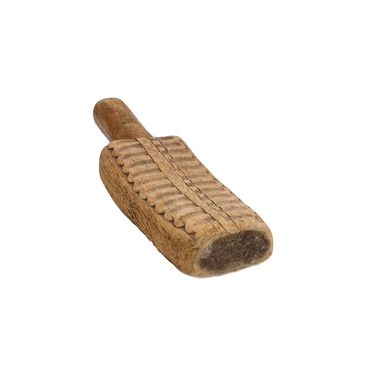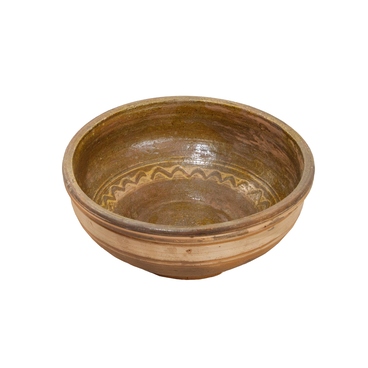The rubel is a wooden board with cut transverse grooves. This tool was used for beating and ironing laundry. It is a wooden rectangular bar of a slightly concave shape with a cylindrical handle and a stop for the hand at the opposite end. The back side of the rubel is decorated with carving, and on the working side there are transverse ribs.
Washed and dried clothes were carefully rolled on a special rolling pin, then the ribbed side of the rubel was put on the roll and rolled on a smooth hard surface. The clothes were rolled several times, with both hands pressing firmly on the roll by the handle and the opposite end. Its ribbed surface kneaded the hard after washing cloth and smoothed out the “wrinkles”. Rolling the laundry required considerable physical effort, but it was done only by women.
Hardwood of deciduous species: oak, mountain ash, beech, maple, birch was used for making rubels. The ends of the rubel were evenly sawn, sharp corners on the edges were rounded with a file. Then on the lower surface of the rubel they carved “rolls”. To do this, they drew parallel lines at regular intervals on the surface and made kerfs 7 millimeters deep. The wood was cut from their edges with a chisel towards the kerf, getting grooves between the rollers. Then sharp edges were smoothed out with a chisel, giving them a rounded shape.
Rubel was used not only for ironing clothes, but also as a musical instrument. The difference between the musical and household rubel is that the first was hollow, while the second was solid. A resonator cavity was drilled into one of the sides, which made the sound loud and echoing. In addition, the musical rubel was shorter than the usual one, and its cuts had sharper edges.
When playing the rubel, the musician it held by the handle with one hand, and moved the other hand back and forth on its ribs with a wooden spoon or stick. This produced a characteristic “rattling” sound. Even today rubels sometimes used in orchestras of folk instruments and in folklore groups.
Washed and dried clothes were carefully rolled on a special rolling pin, then the ribbed side of the rubel was put on the roll and rolled on a smooth hard surface. The clothes were rolled several times, with both hands pressing firmly on the roll by the handle and the opposite end. Its ribbed surface kneaded the hard after washing cloth and smoothed out the “wrinkles”. Rolling the laundry required considerable physical effort, but it was done only by women.
Hardwood of deciduous species: oak, mountain ash, beech, maple, birch was used for making rubels. The ends of the rubel were evenly sawn, sharp corners on the edges were rounded with a file. Then on the lower surface of the rubel they carved “rolls”. To do this, they drew parallel lines at regular intervals on the surface and made kerfs 7 millimeters deep. The wood was cut from their edges with a chisel towards the kerf, getting grooves between the rollers. Then sharp edges were smoothed out with a chisel, giving them a rounded shape.
Rubel was used not only for ironing clothes, but also as a musical instrument. The difference between the musical and household rubel is that the first was hollow, while the second was solid. A resonator cavity was drilled into one of the sides, which made the sound loud and echoing. In addition, the musical rubel was shorter than the usual one, and its cuts had sharper edges.
When playing the rubel, the musician it held by the handle with one hand, and moved the other hand back and forth on its ribs with a wooden spoon or stick. This produced a characteristic “rattling” sound. Even today rubels sometimes used in orchestras of folk instruments and in folklore groups.



